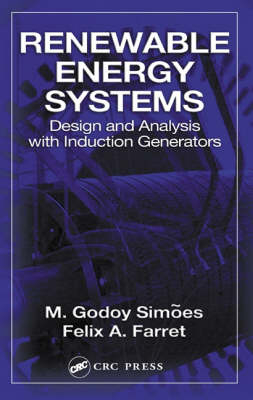
Renewable Energy Systems
Crc Press Inc (Verlag)
978-0-8493-2031-6 (ISBN)
- Titel erscheint in neuer Auflage
- Artikel merken
As the world moves toward renewable energy sources to combat environmental and power distribution issues, there has been a resurgence of interest in induction generators, particularly in their use in wind and hydropower generation systems. Induction machines operating as generators are rugged and cost effective, and with recent advances in control and optimization, the control design aspects are now moving from the laboratory to the desks of practicing engineers.
Renewable Energy Systems: Design and Analysis with Induction Generators presents the first comprehensive exposition of induction machines used for power generation. Focusing on renewable energy applications, the authors address virtually all aspects of the design, operation, and analysis of these systems, from the very basics to the latest technologies, including:
New methods of characteristics testing, aimed at reduced test time, precision, and automation
Reactive compensation techniques
Control, including scalar control, vector control, and optimization techniques for peak power tracking control
Interconnecting induction generators to the main grid
Behavior in the presence of switched and controlled electronic converters
Using PSPICE, MATLAB, PSIM, C, Pascal and Excel for modeling and simulation
Robust, economical, and low maintenance, induction generators hold outstanding potential for helping to fulfill the world's energy needs. This book provides the background and the tools you need to begin developing power plants and become expert in the applications and deployment of induction generator systems.
PRINCIPLES OF RENEWABLE SOURCES OF ENERGY AND ELECTRIC GENERATION
Scope of This Chapter
Legal Definitions
Principles of Electrical Conversion
Basic Definitions of Electrical Power
Characteristics of Primary Sources
Characteristics of Remote Industrial, Commercial, Residential Sites and Rural Energy
Selection of the Electric Generator
Interfacing Primary Source, Generator, and Load
An Example of a Simple Integrated Generating and Energy-Storing System
Problems
References
THE STEADY STATE MODEL OF THE INDUCTION GENERATOR
Scope of This Chapter
Classical Steady-State Representation of the Asynchronous Machine
Generated Power
Induced Torque
Representation of the Induction Generator Losses
Measurement of Induction Generator Parameters
Peculiarities of the Induction Machine Working as a Generator
Interconnected to the Distribution Network
The High Efficiency Induction Generator
The Doubly Fed Induction Generator
Problems
References
THE TRANSIENT MODEL OF THE INDUCTION GENERATOR
Scope of this Chapter
An Example of an Induction Machine in a Transient State
State Space Based Induction Generator Modeling
Partition of the SEIG State Matrix with an RLC Load
Generalization of the Association of Self-Excited Generators
The Relationship between Torque and Shaft Oscillation
Transient Simulation of Induction Generators
Using This Chapter to Solve Typical Problems
Problems
References
THE SELF-EXCITED INDUCTION GENERATOR
Scope of This Chapter
Performance of the Self-Excited Induction Generator
Voltage Regulation
Magnetizing Curves and Self-Excitation
Mathematical Description of the Self-Excitation Process
Series Capacitors and Composed Excitation of the Induction Generator
Problems
References
GENERAL CHARACTERISTICS OF THE INDUCTION GENERATOR
Scope of this Chapter
Torque-Speed Characteristics of the Induction Generator
Power Versus Current Characteristics
The Rotor Power Factor in Rotation
The Nonlinear Relationship Between Air-Gap Voltage V g and Magnetizing Current Im
An Example of Determination of the Magnetizing Curve and the Magnetizing Reactance
Voltage Regulation
Characteristics of Rotation
Problems
References
CONSTRUCTION FEATURES OF THE INDUCTION GENERATOR
Scope of This Chapter
Electromechanical Considerations
Optimization of the Manufacturing Process
Types of Design
Sizing the Machine
Efficiency Issues
Problems
References
POWER ELECTRONICS FOR INTERFACING INDUCTION GENERATORS
Scope of This Chapter
Power Semiconductor Devices
Power Electronics and Converter Circuits
DC to DC Conversion
AC to DC Conversion
DC to AC Conversion
AC to AC Conversion
Problems
References
SCALAR CONTROL FOR INDUCTION GENERATORS
Scope of This Chapter
Scalar Control Background
Scalar Control Schemes
Problems
References
VECTOR CONTROL FOR INDUCTION GENERATORS
Scope of This Chapter
Vector Control for Induction Generators
Axis Transformation
Space Vector Notation
Field-Oriented Control
Problems
References
OPTIMIZED CONTROL FOR INDUCTION GENERATORS
Scope of This Chapter
Why Optimize Induction-Generator-Based Renewable Energy Systems?
Optimization Principles: Optimize Benefit or Minimize Effort
Application of Hill Climbing Control (HCC) for Induction Generators
HCC-Based Maximum Power Search
Fuzzy Logic Control (FLC)-Based Maximum Power Search
Problems
References
WOUND-ROTOR INDUCTION-GENERATOR SYSTEMS
Scope of This Chapter
Features of WRIG
Sub- and Supersynchronous Modes
Operation of WRIG
Problems
References
SIMULATION TOOLS FOR THE INDUCTION GENERATOR
Scope of This Chapter
Design Fundamentals of Small Power Plants
Simplified Design of a Small Wind Power Plant
Simulation of the Self-Excited Induction Generator in PSpice
Simulation of a Self-Excited Induction Generator in Pascal
Simulation of the Steady-State Operation of an Induction Generator using Microsoft Excel
Simulation of Vector-Controlled Schemes Using MatLab/Simulink
Simulation of a Self-Excited Induction Generator in PSim
Simulation of a Self-Excited Induction Generator in MATLAB
Problems
References
THE ECONOMICS OF INDUCTION GENERATOR-BASED RENEWABLE
SYSTEMS
Scope of This Chapter
Optimal and Market Price of Energy in a Regulatory Environment
World Climate Change Related to Power Generation
Appraisal of Investment
Concept Selection and Optimization of Investment
Future Directions
Problems
References
APPENDIX
Introduction to Fuzzy Logic
C Statements for Simulation of a Self-Excited Induction Generator
Pascal Statements for Simulation of a Self-Excited Induction Generator
Index
| Erscheint lt. Verlag | 11.5.2004 |
|---|---|
| Reihe/Serie | Power Electronics and Applications Series |
| Zusatzinfo | 29 Tables, black and white; 220 Illustrations, black and white |
| Verlagsort | Bosa Roca |
| Sprache | englisch |
| Maße | 156 x 235 mm |
| Gewicht | 667 g |
| Themenwelt | Technik ► Elektrotechnik / Energietechnik |
| ISBN-10 | 0-8493-2031-3 / 0849320313 |
| ISBN-13 | 978-0-8493-2031-6 / 9780849320316 |
| Zustand | Neuware |
| Haben Sie eine Frage zum Produkt? |
aus dem Bereich



